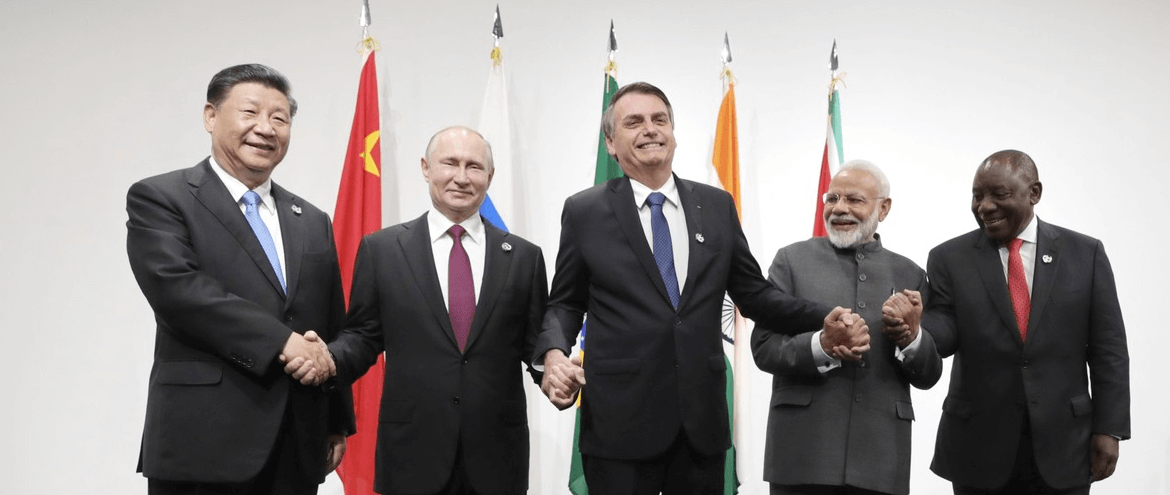The 11th BRICS summit, held earlier this week in Brasilia, produced the Brasilia Declaration. Among other things, the document reiterates the "fundamental importance of a rules-based, transparent, nondiscriminatory, open, free and inclusive international trade".
While many see this clause as a show of support for fellow member state China in the ongoing US-China trade war, India's protectionism draws into question the ability of the BRICS to ensure its compliance to the Declaration.
Global Trade Affairs data shows that India is only second behind the United States in imposing trade restrictions from the G20 group. In fact, it has been described as unpredictable and opaque by the US Trade Department for its high tariffs, which average at 13.8 per cent.
Post-independence, in a continuing wave of swadeshi, India tried to survive with minimal international trade for as long as it could but officially ditched this model in the 1990s after a currency crisis. Policymakers then approached the International Monetary Fund for assistance, which came at the cost of India opening its economy to foreign investment and removing trade barriers.
This liberalization of India’s economy and its integration into the international political economy has been successful so far. When Modi took office in 2014, promises were made to boost the economy by increasing foreign investments. At the same time, the Make in India campaign was launched in a bid to grow domestic businesses.
While many laud Modi for improving India’s ease of doing business, it has been found that in terms of international trade, the numbers reflect not only a lack of progress, but a negative trajectory. According to the most recent values calculated by the World Bank, India’s trade growth is -1.1 percent, compared to a world growth of 1.5 percent.
In the past two budgets, India has raised tariffs massively under the garb of promoting domestic manufacturing and furthering the Make in India initiative. But manufacturers of organic chemicals, plastics, iron and steel, and electronics still prefer to import materials. However, owing to India's protectionist policies, these materials have become costlier, furthering the cycle of expensive exports and hampering trade.
These moves have completely reversed the efforts of liberalization and have the potential to isolate India and create distrust internationally, particularly with China. Furthermore, protectionism seems to be affecting India’s most disadvantaged, increasing the gap between the rich and the poor, contributing to the domestic economic slowdown.
The Modi government also recently withdrew from the Regional Comprehensive Economic Partnership (RCEP), a multilateral free trade agreement proposed by China. Many consider this a great move, but increased tariffs can also raise the perceived cost of entering other bilateral and multilateral trade deals, as there will always be a wide gap between the tariff rates of India and others.
Therefore, it is important that others in the BRICS hold India accountable to its signature on the Declaration, especially China, whose bilateral trade with India has already gone down by 3.59 percent in the first half of this year. Simultaneously, Modi must also rethink his protectionist policies before they irrevocably damage the domestic economy.
Over the years, BRICS has earned credibility as a middle power, but with four out of five of its members now having right-wing leaders (Modi, Xi Jinping, Vladimir Putin, and Jair Bolsonaro), economic cooperation is under threat. Many of these leaders have already flouted the clauses of the new Declaration, the most glaring being Bolsonaro and his plans to pull out of the Paris Agreement.
Hence while such international treaties are not legally binding, countries must be able to take action against one another for non-compliance to these guidelines, given that they require each member state to pull equal weight. Else, the entire exercise in multilateralism, much like the G7, will be reduced to lip service.
Reference List
Budget smacks of a return to protectionism. (2019). Retrieved 16 November 2019, from https://www.thehindubusinessline.com/opinion/budget-smacks-of-a-return-to-protectionism/article28298927.ece
Chang, S. (2019). Why India is one of world's most protectionist countries. Retrieved 16 November 2019, from https://www.bbc.com/news/business-47857583
In swipe at US, BRICS hit out at protectionism. (2019). Retrieved 16 November 2019, from https://www.thehindubusinessline.com/news/world/in-swipe-at-us-brics-hit-out-at-protectionism/article29980234.ece#
India Trade Statistics | WITS. (2019). Retrieved 16 November 2019, from https://wits.worldbank.org/CountryProfile/en/IND
Kundu, T. (2019). Will protectionism help govt’s ‘Make in India’ plan?. Retrieved 16 November 2019, from https://www.livemint.com/news/india/will-protectionism-help-govt-s-make-in-india-plan-1563171875065.html
Kwatra, N. (2019). Protectionism should worry India. Retrieved 16 November 2019, from https://www.livemint.com/news/india/rising-protectionism-not-rcep-withdrawal-should-worry-indians-11573540972497.html
Ministry of External Affairs. (2019). BRASÍLIA DECLARATION. New Delhi.
Verma, K. (2019). India, China bilateral trade declines by 3.59% in first 5 months of this year. Retrieved 16 November 2019, from https://www.livemint.com/news/india/india-china-bilateral-trade-declines-by-3-59-in-first-5-months-of-this-year-1562697895804.html
Image Source: BRICS Brasil 2019

